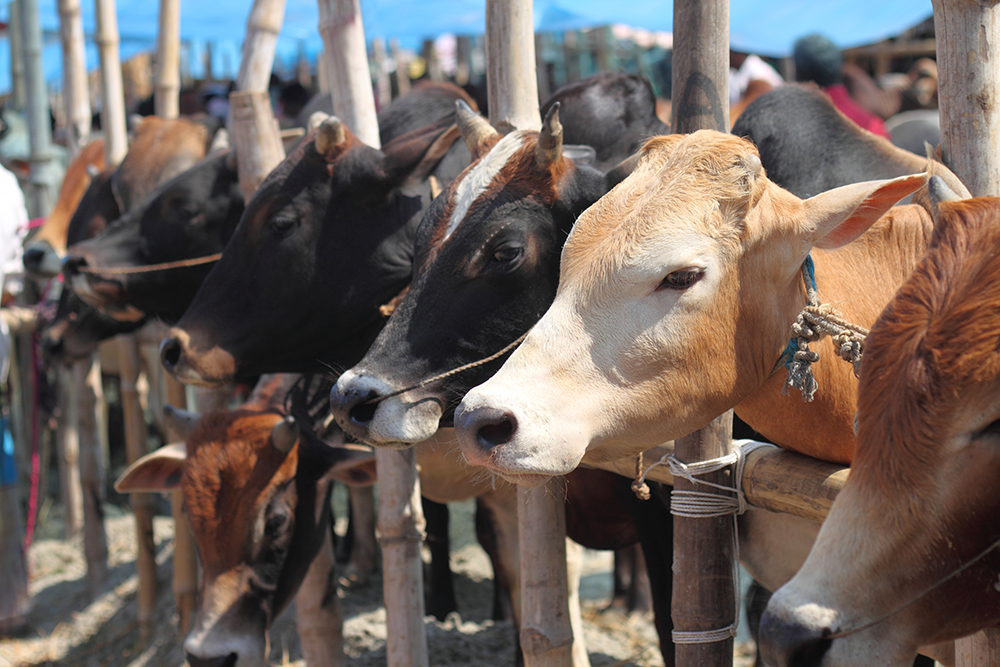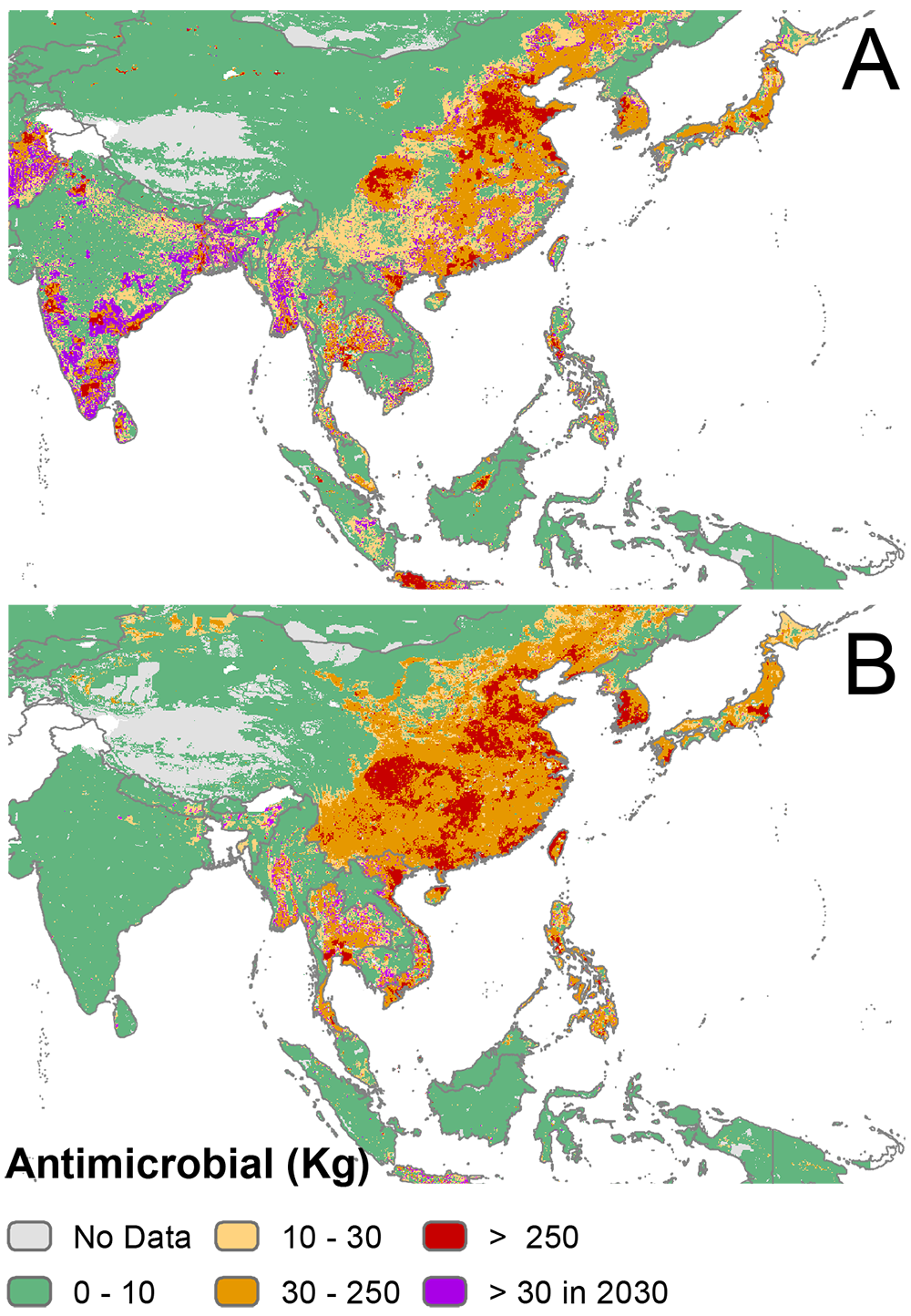Growth In Livestock Antibiotics Raises Risks For Humans
Air Date: Week of April 3, 2015

Non-therapeutic antibiotic use in livestock allows farmers to keep pigs, cows, and chickens in less hygienic conditions without getting sick. (Photo: Bigstockphoto)
Increasingly bacteria are developing antibiotic resistance, making us vulnerable to all sorts of superbugs. Inappropriate or over prescription for humans is one cause, but Ramanan Laxminarayan, a Princeton University Professor specializing in disease and socio-economics, tells host Steve Curwood that a larger problem could be the overuse of antibiotics in animal agriculture.
Transcript
CURWOOD: President Obama has just announced a five-year plan to combat rising antibiotic resistance – and one particular area of focus is the overuse of these drugs in the livestock industry. A recent study documents how the use of antibiotics in farm animals is rising around the world, especially in less affluent nations. Joining us now to discuss the problem is the lead author and Princeton Professor Ramanan Laxminarayan.
LAXMINARAYAN: Way back in the 1950s, a bunch of scientists discovered that by giving antibiotics in very small concentrations to livestock, to poultry, to hogs, to cattle, that they could grow much faster and disease could be prevented and you could bring them to market a lot sooner. Now, all this was helpful back in the day when there was an increased demand for animal protein, particularly in the post-World War period. And over time these practices continued, but the use of antibiotics in sub-therapeutic concentrations has also been known to increase resistance in bacteria.
CURWOOD: Now, you've looked at how this practice of feeding antibiotics to livestock to enhance production is playing out around the world and the question of antibiotic resistance. What did you find?
LAXMINARAYAN: So we found, first of all, that the practice of antibiotic use in sub-therapeutic concentrations is not a developed country phenomenon any more. It's now widespread in countries like Kenya, South Africa, India, China and the demand for animal protein in these countries is increasing at a prodigious pace. We estimated at about a consumption in the livestock industry for the world, particularly in low-and-middle income countries and we estimate that this use could go up by about 67 percent just between 2010 and 2030, which is a remarkable increase given that use right now is at a fairly high figure of 63,000 tons. Two-thirds of that increase is because of the increase in demand of animal protein and about a third is because of the shift to more intensive production systems that need antibiotics if it's not a modern facility.

The use of antibiotics for livestock is on the rise, particularly in China and India. (Photo: Bigstockphoto)
CURWOOD: So where are the places where you seeing this really rapid rise in the use of antibiotics in agriculture?
LAXMINARAYAN: So we see the rapid rise in places where demand for animal protein is increasing the most. So that is in large parts of China where populations are pretty high at the moment and where people are getting wealthier. And one thing which people do when they get wealthier is to eat more meat. In fact it is a sign of actual wealth in terms of being able to afford to eat more meat. We also see this in parts of India, particularly in coastal South India, where again rising incomes are leading to increased meat consumption.
CURWOOD: Isn't there kind of a yuck factor here if people know that these animals are being raised in such filth that they must have antibiotics? It feels kind of unappetizing?
LAXMINARAYAN: Well, the fact is that most people don't know that their animals are fed antibiotics on a constant basis. In fact, I would suspect that is true even of the US population. It's only now that people are beginning to realize that there is such a thing as antibiotic free meat, which then means that the rest of the meat must not be antibiotic free. I don't think a lot of people realize that this phenomenon of feeding the animals day after day in low concentrations is quite widespread. I think this is a well-kept secret.

Antibiotic consumption by chickens (Image A) and pigs (Image B) across Asia as of 2010. Purple areas are where consumption is expected to increase significantly by 2030—most noticeably, use in chickens in India. (Photo: PNAS)
CURWOOD: Talk to me a bit, professor, how the use of antibiotics for livestock has an effect on human health?
LAXMINARAYAN: So any use of antibiotics, whether in humans or in animals places selection pressure for resistant bacteria to thrive. So this is just Darwinian selection. We kill off the sensitive bacteria; we let the resistant ones survive. So the same mechanisms are operating in bacteria whether they're in humans and animals. And although we think of the bacteria in our bodies as our own, we actually have far more bacteria in our bodies than we have even human cells and we essentially inhabit the world of bacteria. So we're passing these bacteria back and forth to the animals, back to ourselves, and it's a free flow of both the bacteria as well as these genes that encode for resistance. So there is no such thing is your bacteria which is separate from mine and different from your dog's or different from the chicken that's being raised on the farm next door. It's one common pool of bacteria that's shared. So when we use antibiotics in large volumes, whether in humans or animals, we're essentially putting ourselves at risk for having infections that are caused by organisms that don't respond to antibiotics.
CURWOOD: And what about treating infections? What are some of the particular diseases that you're especially concerned about?

Antibiotic use per kilogram of animal species in developed countries. (Photo: PNAS)
LAXMINARAYAN: So, bacterial infections typically cause one of three things for the most part. So they either cause urinary tract infections, UTIs that a lot of people are familiar with, pneumonia, or sepsis, which is bloodstream infections, and all three of these are caused by a wide range of bacteria. Nearly all of which are resistant to some and some of these to all of the antibiotics that we have right now. So when you hear about us entering a post antibiotic era it's because we now actually have infections in our hospitals that no antibiotic will cure and there's not very much a doctor can do for the patient. But what a lot of people don't realize is that common procedures whether this is having a biopsy or having a C-section, we need antibiotics in order to be able to perform these procedures because without antibiotics there is a risk of infection which would then make the outcomes for these procedures a lot worse than they are right now. So much of what constitutes modern medicine really depends on our ability to be able to have an efficient way to prevent infections and the best way we know how is through antibiotics.
CURWOOD: How is this affecting people seeking treatment for infections in less developed countries at this point?

Ramanan Laxminarayan (Photo: Princeton University)
LAXMINARAYAN: So unlike those living in developed countries where if the first antibiotic didn't work for you, you could try a second one or a third one - and the third one might cost hundreds of dollars, perhaps even thousands of dollars - the average patient in a low-income country probably can't afford the antibiotic that probably costs more than a dollar a dose, so maybe even in a couple dollars a dose. So the loss of antibiotic effectiveness is far more profound in terms of impacts on health in low-and-middle income countries because of the inability to be able to afford more expensive antibiotics. Now increasing access to antibiotics for these populations is a good thing because these folks never had antibiotics to begin with to treat infections. But the tragedy of resistance is that when these folks actually get wealthy enough to be able to afford an antibiotic, these drugs won't work.
CURWOOD: Professor Ramanan Laxminarayan is a Senior Research Scholar at the Princeton Environmental Institute in Princeton, New Jersey. Thanks for joining us.
LAXMINARAYAN: My pleasure.
CURWOOD: The Professor’s research suggests it would cost little to reduce antibiotic use in animals in the US, but that’s less true in the challenging conditions of the developing world. There's a link to all this research on our website LOE.org.
Links
Listen to Ramanan Laxminarayan’s TED Talk on antibiotic resistance
Read the original article on the rise of antibiotics in PNAS
Dr. Laxminarayan’s paper on the cost of withdrawing antibiotics from the livestock sector
Living on Earth wants to hear from you!
Living on Earth
62 Calef Highway, Suite 212
Lee, NH 03861
Telephone: 617-287-4121
E-mail: comments@loe.org
Newsletter [Click here]
Donate to Living on Earth!
Living on Earth is an independent media program and relies entirely on contributions from listeners and institutions supporting public service. Please donate now to preserve an independent environmental voice.
NewsletterLiving on Earth offers a weekly delivery of the show's rundown to your mailbox. Sign up for our newsletter today!
 Sailors For The Sea: Be the change you want to sea.
Sailors For The Sea: Be the change you want to sea.
 The Grantham Foundation for the Protection of the Environment: Committed to protecting and improving the health of the global environment.
The Grantham Foundation for the Protection of the Environment: Committed to protecting and improving the health of the global environment.
 Contribute to Living on Earth and receive, as our gift to you, an archival print of one of Mark Seth Lender's extraordinary wildlife photographs. Follow the link to see Mark's current collection of photographs.
Contribute to Living on Earth and receive, as our gift to you, an archival print of one of Mark Seth Lender's extraordinary wildlife photographs. Follow the link to see Mark's current collection of photographs.
 Buy a signed copy of Mark Seth Lender's book Smeagull the Seagull & support Living on Earth
Buy a signed copy of Mark Seth Lender's book Smeagull the Seagull & support Living on Earth

